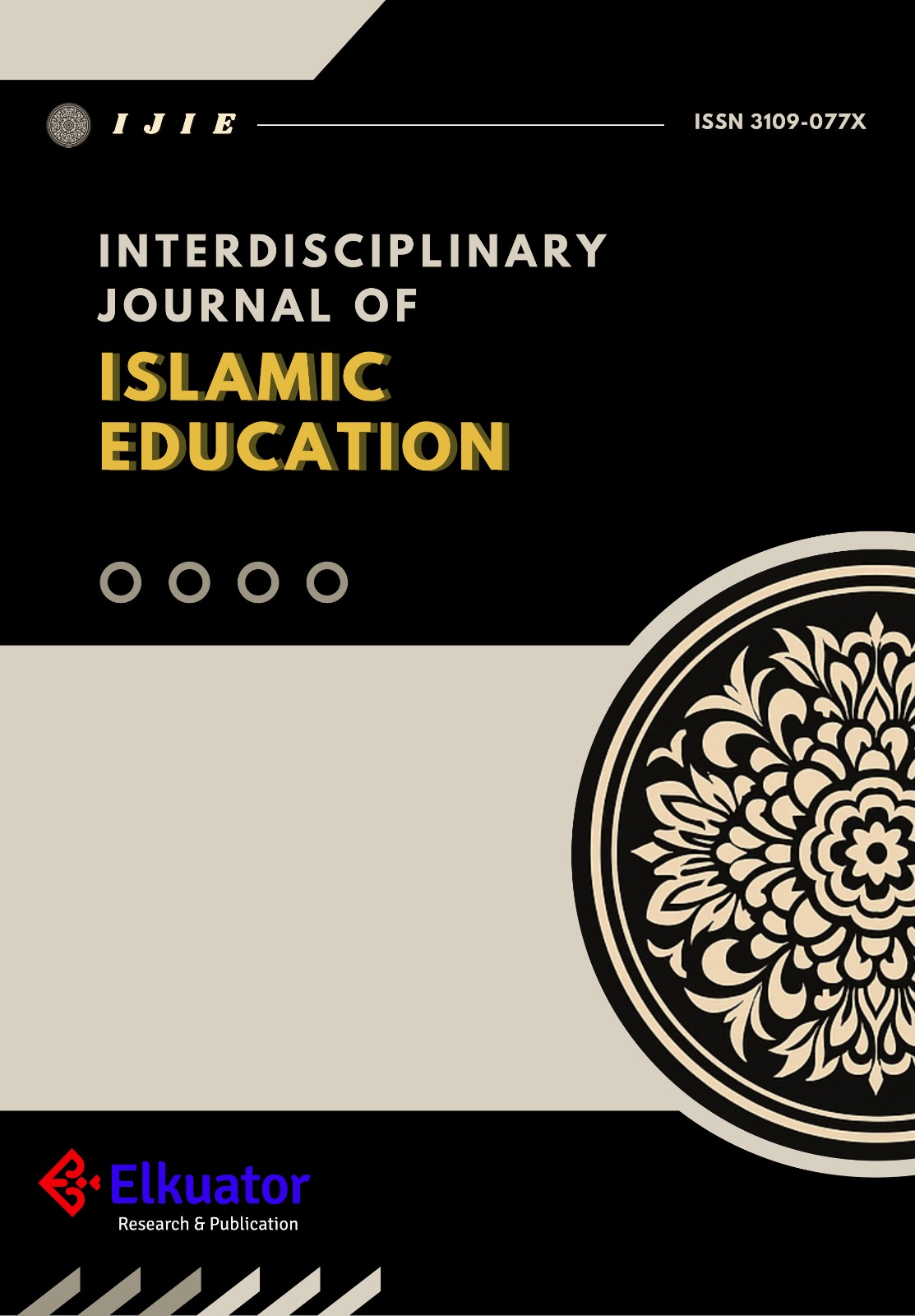The Dialectics of Text and Reason: Badr al-Dīn al-Zarkashī's Contribution to Qur’anic Interpretive Methodology in the 8th Century Hijriyah
DOI:
https://doi.org/10.24260/basmala.1.1.65Keywords:
Badr al-Dīn al-Zarkashī, Qur’anic Hermeneutics, al-Burhān fī ʿUlūm al-Qurʾān, Ijtihād, RaʾyAbstract
This research comprehensively analyzes the methodological framework of Qur’anic interpretation according to Badr ad-Dīn az-Zarkasyi, as outlined in al-Burhān fī ʿUlūm al-Qurʾān. The study aims to fill a gap in the literature that often overlooks the legitimacy of raʾy (reason/ijtihād) in al-Zarkashī’s methodology, especially in light of the general perception regarding the dominance of the transmissive-static approach in Sunni exegesis during the 8th century Hijri. Using Gadamer’s hermeneutic framework, this research carefully explores how al-Zarkashīcategorizes the verses of the Qur’an, identifies the sources of his interpretations, and formulates the mechanism of ijtihād as a fundamental and legitimate tool for meaning-making. From a deep analysis, a crucial finding emerged: al-Zarkashī explicitly distinguishes between interpretation based on narration and taʾwīl that involves ijtihād, opening significant space for the use of reason for verses that do not have a definitive interpretation (qath’i). He emphasizes the necessity of ijtihād so that the Qur’an can continuously engage in dialectics with the dynamics of the times (tanazzul), even daring to reinterpret hadiths that are often misunderstood as prohibitions against raʾy with strong arguments. The methodology of ijtihād that he advocates is very solid, deeply rooted in the mastery of Arabic linguistic knowledge and uṣūl al-fiqh (principles of Islamic jurisprudence). This finding not only enriches the “big picture” of the history of Sunni exegesis in the medieval period by demonstrating that the philological-dialectical model accommodating raʾy (opinion) remains significant, but it also positions al-Zarkashī as an important figure who successfully bridges tradition and progressiveness in the realm of Islamic interpretative thought
[Penelitian ini menganalisis secara komprehensif kerangka metodologis penafsiran al-Qur’an menurut Badr ad-Dīn al-Zarkashī sebagaimana tertulis dalam al-Burhān fī ʿUlūm al-Qurʾān. Kajian ini berupaya mengisi celah dalam literatur yang seringkali kurang menyoroti secara mendalam legitimasi raʾy (rasio/ijtihād) dalam metodologi al-Zarkashī, terutama di tengah pandangan umum mengenai dominasi pendekatan transmitif-statis dalam tafsir Sunni pada abad ke-8 Hijriah. Dengan menggunakan kerangka hermeneutika Gadamer, penelitian ini menelusuri secara cermat bagaimana al-Zarkashī mengkategorikan ayat-ayat Al-Qur’an, mengidentifikasi sumber-sumber interpretasinya, dan merumuskan mekanisme ijtihād sebagai alat pemaknaan yang fundamental dan sah. Dari analisis mendalam, terungkap sebuah temuan krusial: al-Zarkashī secara eksplisit membedakan antara tafsir yang berbasis riwayat dan taʾwīl yang melibatkan ijtihād, membuka ruang signifikan bagi penggunaan rasio untuk ayat-ayat yang belum memiliki penafsiran yang qath'i. Ia menegaskan perlunya ijtihād agar Al-Qur’an senantiasa berdialektika dengan dinamika zaman (tanazzul), bahkan berani mereinterpretasi hadis-hadis yang sering disalahpahami sebagai pelarangan raʾy dengan argumen yang kokoh. Metodologi ijtihād yang ia usung sangat solid, berakar kuat pada penguasaan ilmu kebahasaan Arab dan uṣūl al-fiqh. Temuan ini tidak hanya memperkaya “peta besar” sejarah tafsir Sunni abad pertengahan dengan menunjukkan bahwa model filologis-dialektis yang akomodatif terhadap raʾy tetap signifikan, tetapi juga menempatkan al-Zarkashī sebagai figur penting yang berhasil menjembatani tradisi dan progresivitas dalam khazanah pemikiran interpretatif Islam.]
References
Al-Walid, Kholid. “Takwil Epistemologis Ibn Sînâ Atas Surah Al-Nûr ayat 35.” Ulul Albab Jurnal Studi Islam 19, no. 1 (June 25, 2018): 1–24.
Alwani, Zainab. “Al-Waḥda al-Bināʾiyya Li-l-Qurʾān: A Methodology for Understanding the Qurʾān in the Modern Day.” Journal of Islamic Faith and Practice 1, no. 1 (March 9, 2018).
Anas, Malik bin. Al-Muwatta’. Vol. 2. Bairut: Muassah Ar-Risalah, 1991.
Asfahani, Al-Ragib al-. Mufradat Al-Faz al-Qur’an. Bairut: Daral-Qalam, Damaskus.
Asqallani, Ibn Hajar al-’. Al-Durar al-Kaminah Fi al-A’yan al-Mi’ah al-Saminah. Vol. 3. Bairut: Dar al-Jail, 1993.
———. Inba’ al-Gumar Bi Anba’ al-Gumar. Vol. 1. Kaior: Dar Ihya’ al-Turas al-Islami, 1998.
———. Nukhbah Al-Fikr: Fi Mustalah Ahli Asar. Bairut: Dar Ibn hazm, 2006.
Elkarimah, Mia Fitriah. “Munasabah in the Perspective of Science of the Qur’an: Study of Al-Burhan Fi Ulum al-Qur’an Works of al-Zarkasyi (D. 749 H).” Al-Risalah: Jurnal Studi Agama dan Pemikiran Islam 14, no. 1 (2023): 47–61.
Faiz, Fakhuruddin. Hermeneutika Al-Qur’an. Yogyakarta: al-Qalam, 2002.
“Filologi.” Accessed August 14, 2023. https://kbbi.kemdikbud.go.id/entri/filologi.
Firdaus, Yelmi Eri, Elfia Elfia, and Meirison. “Rise and Fall of Mamluk Sultanate: The Struggle Against Mongols and Crusaders in Holy War.” Al-Adyan: Journal of Religious Studies 1, no. 1 (August 6, 2020): 14–28.
G. E., Bosworth. Dinasti-Dinasti Islam. Terj. Ilyas Hasan. Bandung: Mizan, 1993.
Ghazali, Abu Hamid al-. Misykat Al-Anwar. Mesir: Dar al-Qaumiyah, t.th.
Ghozali, Moh Alwy Amru. “Takwil dalam Perspektif Abdul Jabbar (Sebuah Tawaran Hermeneutika al-Qur’an).” Dialogia 14, no. 2 (January 20, 2017): 165–85.
Hardiman, F. Budi. Seni Memahami Hermeneutik Dari Schleiermacher Sapai Deridda. Yogyakarta: PT Kanisius, 2015.
Hariyanto, Ahmad. “Tafsir Era Nabi Muhammad SAW.” Jurnal At-Tibyan 1, no. 1 (June 2016): 70–93.
Hidayat, Komarudin. Memahami Bahasa Agama: Sebuah Pendekatan Heremeneutik. Jakarta: Paramadina, 1996.
Ibn Kasir, al-Hafiz. Tafsir Al-Qur’an al-’Azim. Vol. 1. Bairut: Dar al-Kutub al-’Imiyah, 2012.
Ibn Mulqin, Siraj ad-Din. At-Taudih Li Syarh al-Jami’ al-Sahih. Vol. 2. Damaskus: Dar An-Nawadir, 2008.
Ibn Taimiyyah, Ahmad. Muqaddimah Fi Ushul At-Tafsir. Bairut: Dar Ibn hazm, 1993.
Iyazi, Muhammad Ali. Al-Mufassirun Hayatuhum Wa Manhajuhum. Vol. 1. Teheran: Wizarah al-Saqafah wa al-Irsyad al-Islami, 1966.
———. Al-Mufassirun Hayatuhum Wa Manhajuhum. Vol. 3. Teheran: Wizarah al-Saqafah wa al-Irsyad al-Islami, 1966.
Jonwari, and Faiz Zainuddin. “Konsep Tafsir Dan Takwil Dalam Perspektif As-Syatibi.” Jurnal Lisan Al-Hal 14, no. 2 (Desember 2020).
Khair, Nurul, Ahmed Zaranggi Ar Ridho, and Siti Hadaynayah Salsabila. “Takwil As-Sirāṭ Al-Mustaqīm dalam Pembacaan Tafsir Mulla Sadra.” Journal of Qur’an and Hadith Studies 9, no. 2 (December 30, 2020): 29–54.
McAuliffe, Jane Dammen. The Wiley Blackwell Companion to the Qur’an. Chichester, UK: Wiley-Blackwell, 2017.
Mir, Mustansir. Coherence in the Qur’an. New York: Palgrave Macmillan, 2011.
Noer, Kautsar Azari. “Hermeneutika Sufi Sebuah Kajian Atas Pandangan ibn Arabi Tentang Takwil Al-Qur’an” 2, no. 2 (February 2, 2013).
Qadafy, Mu’ammar Zayn. “Menghidupkan Yang Mati Suri: Walid Saleh Dan Revitalisasi Kajian Sejarah Intelektual Tafsir Klasik.” Suhuf 15, no. 2 (2022).
Ross, Stewart. Qur’an Commentary and the Biblical Turn: A History of Muslim Exegetical Engagement with the Biblical Text. London: Routledge, 2024.
Saleh, W. “The Etymological Fallacy and Qur’anic Studies: Muhammad, Paradise, and Late Antiquity.” In The Qur’ān in Context: Historical and Literary Investigations into the Qur’ānic Milieu, edited by N. S. Angelika Newrith and Michael Marx. Brill, 2010.
Saleh, Walid. “Ibn Taymiyya and the Rise of Radical Hermeneutics: An Analysis of an Introduction to the Foundations of Qurʾānic Exegesis.” In Ibn Taymiyya and His Times, edited by Yossef Rapoport and Shahab Ahmed, 123--162. Karachi: Oxford University Press, 2010.
Saleh, Walid A. “Preliminary Remarks on the Historiography of Tafsīr in Arabic: A History of the Book Approach.” Journal of Qur’anic Studies 12 (2010): 6–40.
Sariri, Maulud as-. Syarh Nayl Al-Muna Fi Nazm al-Muwafaqat Li Asy-Syatibi. Vol. 4. Bairut: Dar al-Kutub al-’Imiyah, 2015.
Suyuti, Abd al-Rahman. Al-Itqan Fi Ulum al-Qur’an. Madinah: Majma’ al-Malik Fahd li Tiba’ah al-Mushaf Asy-Syarif, 1873.
Syamsuddin, Sahiron. Hermeneutika dan Pengembangan Ulum Al-Qur’an. Yogyakarta: Pesantren Nawasesa Press, 2017.
Tabari, Ibn Jarir at-. Jami’ al-Bayan ’an Ta’wil Ay al-Qur’an. Vol. 11. Makkah: Dar al-Tarbiyah wa al-Turas, n.d.
“Tafsir.” Accessed May 28, 2023. https://kbbi.kemdikbud.go.id/entri/tafsir.
“Takwil.” Accessed May 28, 2023. https://kbbi.kemdikbud.go.id/entri/takwil.
Ushul Fiqh Metode Ijtihad Hukum Islam. Vol. 2. Yogyakarta: Unimma Press, 2019.
Wathani, Syamsul. “Konstruksi Ta’wil al-Qur’an Ibn Qutaybah (Telaah Hermeneutis-Epistemologis).” Tesis, UIN Sunan Kalijaga, 2016.
Zarkasyi, Muhammad bin Bahadir az-. Al-Bahr al-Muhit Fi Ush al-Fiqh. Vol. 2. Kuwait: Dar as-Safwah, 1992.
———. Al-Burhan Fi ‘Ulum al-Qur’an. Vol. 2. Kairo: Dar Ihya’ al-Kutub al-Arabiyah, 1957.
———. Al-Burhan Fi ’Ulum al-Qur’an. Kairo: Dar al-Hadis, 2006.
———. Al-Burhan Fi Ulum al-Qur’an. Vol. 1. Bairut: Dar al-Fikr, 2009.
———. Al-Burhan Fi ’Ulum al-Qur’an. Vol. 2. Bairut: Dar al-Kutub al-Imilyah, 2012.
———. Salasil Az-Zahab. Madinah: Risalah Doktorah, 2002.
Zarqani, Muhammad Abdul Azim. Manahil Al-’Irfan Fi Ulum al-Qur’an. Vol. 2. Bairut: Dar al-Fikr, 1996.
Downloads
Published
Issue
Section
License
Copyright (c) 2025 Maqdis, Rizqotul Luqi Mufidah (Author)

This work is licensed under a Creative Commons Attribution-NonCommercial 4.0 International License.














